基于STM32的便携式酒精浓度检测仪设计与实现
基于STM32的车载酒精检测系统的设计
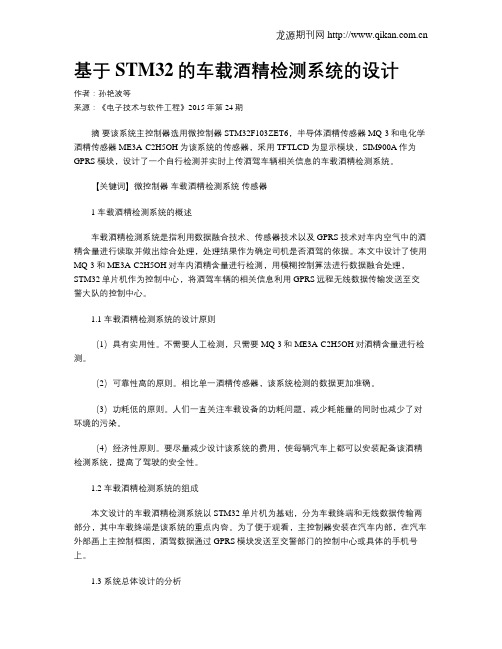
基于STM32的车载酒精检测系统的设计作者:孙艳波等来源:《电子技术与软件工程》2015年第24期摘要该系统主控制器选用微控制器STM32F103ZET6,半导体酒精传感器MQ-3和电化学酒精传感器ME3A-C2H5OH为该系统的传感器,采用TFTLCD为显示模块,SIM900A作为GPRS模块,设计了一个自行检测并实时上传酒驾车辆相关信息的车载酒精检测系统。
【关键词】微控制器车载酒精检测系统传感器1 车载酒精检测系统的概述车载酒精检测系统是指利用数据融合技术、传感器技术以及GPRS技术对车内空气中的酒精含量进行读取并做出综合处理,处理结果作为确定司机是否酒驾的依据。
本文中设计了使用MQ-3和ME3A-C2H5OH对车内酒精含量进行检测,用模糊控制算法进行数据融合处理,STM32单片机作为控制中心,将酒驾车辆的相关信息利用GPRS远程无线数据传输发送至交警大队的控制中心。
1.1 车载酒精检测系统的设计原则(1)具有实用性。
不需要人工检测,只需要MQ-3和ME3A-C2H5OH对酒精含量进行检测。
(2)可靠性高的原则。
相比单一酒精传感器,该系统检测的数据更加准确。
(3)功耗低的原则。
人们一直关注车载设备的功耗问题,减少耗能量的同时也减少了对环境的污染。
(4)经济性原则。
要尽量减少设计该系统的费用,使每辆汽车上都可以安装配备该酒精检测系统,提高了驾驶的安全性。
1.2 车载酒精检测系统的组成本文设计的车载酒精检测系统以STM32单片机为基础,分为车载终端和无线数据传输两部分,其中车载终端是该系统的重点内容。
为了便于观看,主控制器安装在汽车内部,在汽车外部画上主控制框图,酒驾数据通过GPRS模块发送至交警部门的控制中心或具体的手机号上。
1.3 系统总体设计的分析本文设计的车载酒精监测系统是针对酒驾人群的,并且是自动化的,该系统的主要功能是通过酒精传感器对车内酒精含量进行自动检测,并将酒精含量输送至调理电路,调理电路将调理后的信号发送到STM32主控制器上进行数据融合处理,如果酒精含量超过预设值,则通过GPRS网络将酒驾车辆的数据发送至交警部门,从而实现实时监测的目的。
基于单片机技术的酒精浓度检测
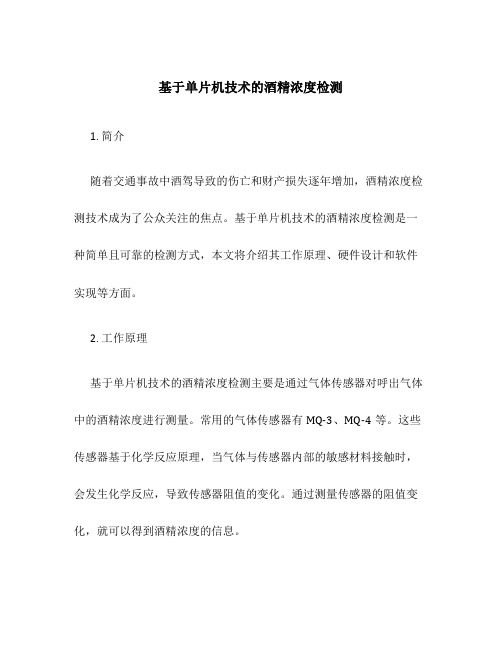
基于单片机技术的酒精浓度检测1. 简介随着交通事故中酒驾导致的伤亡和财产损失逐年增加,酒精浓度检测技术成为了公众关注的焦点。
基于单片机技术的酒精浓度检测是一种简单且可靠的检测方式,本文将介绍其工作原理、硬件设计和软件实现等方面。
2. 工作原理基于单片机技术的酒精浓度检测主要是通过气体传感器对呼出气体中的酒精浓度进行测量。
常用的气体传感器有MQ-3、MQ-4等。
这些传感器基于化学反应原理,当气体与传感器内部的敏感材料接触时,会发生化学反应,导致传感器阻值的变化。
通过测量传感器的阻值变化,就可以得到酒精浓度的信息。
3. 硬件设计基于单片机技术的酒精浓度检测的硬件主要包括单片机模块、气体传感器模块和显示模块。
其中,单片机模块负责读取传感器的阻值,并进行数据处理和显示;气体传感器模块负责检测呼出气体中的酒精浓度;显示模块用于展示酒精浓度信息。
在硬件设计中,需要注意单片机和传感器的接口连接及信号调理,以保证数据的准确性。
另外,还要考虑供电电源的设计,以保证系统的稳定运行。
4. 软件实现基于单片机技术的酒精浓度检测的软件主要包括以下几个方面:4.1 单片机程序设计单片机程序设计主要包括传感器数据读取、数据处理和显示等功能。
通过程序设计,可以实时读取传感器的阻值,并根据阻值的变化计算出酒精浓度。
同时,还需要设计显示功能,将测得的酒精浓度信息显示在液晶屏上。
4.2 数据处理算法在酒精浓度检测中,需要对传感器读取到的数据进行处理,以得到准确的浓度信息。
常见的处理算法有加权平均法、滑动窗口法等。
这些算法可以对传感器测量的数据进行滤波和平滑处理,提高系统的稳定性。
4.3 界面设计界面设计是基于单片机技术的酒精浓度检测中的重要部分。
通过友好的界面设计,用户可以清楚地看到测得的酒精浓度值。
可以采用液晶显示屏或者LED灯等方式来实现界面的设计。
5. 应用场景基于单片机技术的酒精浓度检测广泛应用于交通领域。
例如,在汽车驾驶中,驾驶员可以通过这种酒精浓度检测装置来检测自身是否饮酒后驾驶。
STM32单片机酒精检测防酒驾系统酒精报警器设计
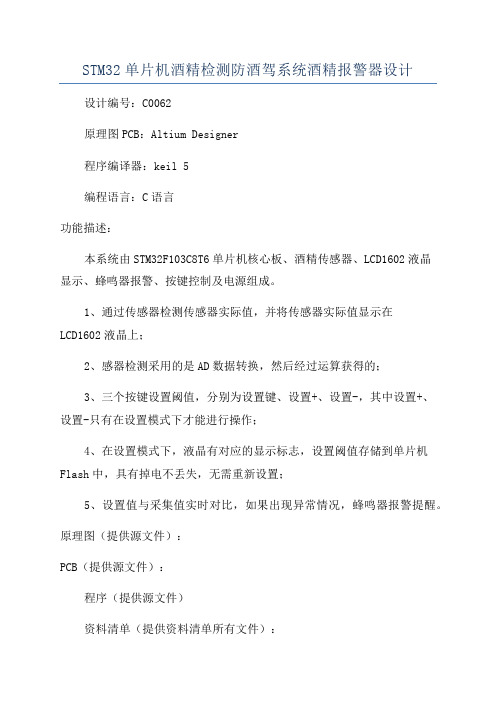
STM32单片机酒精检测防酒驾系统酒精报警器设计
设计编号:C0062
原理图PCB:Altium Designer
程序编译器:keil 5
编程语言:C语言
功能描述:
本系统由STM32F103C8T6单片机核心板、酒精传感器、LCD1602液晶
显示、蜂鸣器报警、按键控制及电源组成。
1、通过传感器检测传感器实际值,并将传感器实际值显示在
LCD1602液晶上;
2、感器检测采用的是AD数据转换,然后经过运算获得的;
3、三个按键设置阈值,分别为设置键、设置+、设置-,其中设置+、
设置-只有在设置模式下才能进行操作;
4、在设置模式下,液晶有对应的显示标志,设置阈值存储到单片机Flash中,具有掉电不丢失,无需重新设置;
5、设置值与采集值实时对比,如果出现异常情况,蜂鸣器报警提醒。
原理图(提供源文件):
PCB(提供源文件):
程序(提供源文件)
资料清单(提供资料清单所有文件):。
基于STM32的便携式多功能医用检测仪的研究
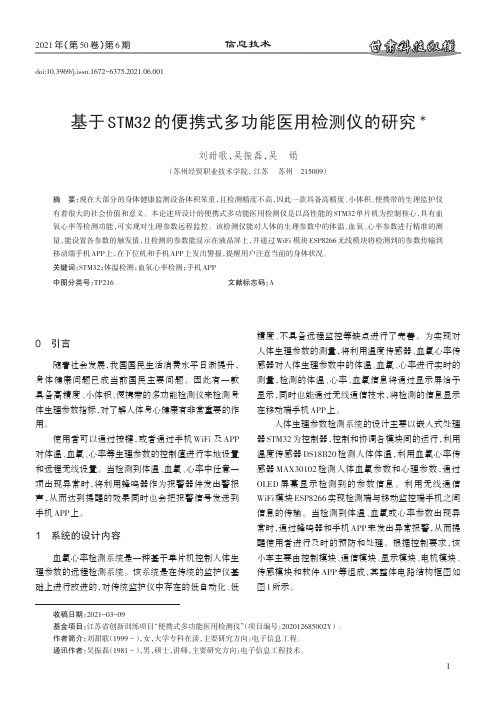
DS18B20 在工作时,传感器中的低温系数晶振和 高温系数晶振,这两者所产生的晶体震荡频率,都会因
2
受到外部的不同温度变化而产生相应的影响,如将低 温系数晶振表示为 Y1,而高温系数晶振表示 Y2,当 DS18B20 受到外面温度的影响时,Y1 就会受到影响,但 该影响相对较小,而 Y2 也会受到影响,但 Y2 的影响会 发生很大。Y1 所产生的脉冲信号将输入到计数器 1 中,而 Y2 所产生的脉冲信号将输入到计数器 2 中。如 将计数器 1 表示为 C1,计数器 2 表示为 C2,DS18B20 在 开始之前就会在 C1 和温度寄存器中设置一个温度基 数,这个基数值是一个和-55 ℃温度值相匹配的值。在 DS18B20 工作时,C1 每次接受到 Y1 所产生的脉冲信号 后,C1 就会做出相应的反应,即自动对当前的基数进行 减操作(自动减 1),直到将设置的基数值为 0 ℃,而这 时的温度寄存器将自动进行加操作(自动加 1),与此同 时 C1 也将自动循环进行重载基数的操作,该循环操作 一直到 C2 数值为 0 ℃为止,温度寄存器中的数值将不再 进行加 1 操作,而下一个时钟周期后,将读出寄存器中的 数值,此时读出的数值便是当前所测量的物体温度值。 2.3 心率血氧检测模块
基于单片机的便携式酒精浓度测试仪设计与实现

单片机STC12C5A16AD的特点,设计该测试仪,以满足不同应用场合,对酒驾行为进行提前预防,保障人民群众的生命安全。
1 系统总体设计■1.1 功能设计本设计基于STC12C5A60S2微处理器,用于检测气体中的酒精浓度,可使用在一些对环境酒精气体浓度要求严格的生产车间,本设计可以及时检测车间内的气体酒精浓度。
当气体酒精浓度高于设定阈值时,发出告警提示,提醒车间管理者及时通风换气,以便于安全生产。
除此之外,还可用于酒驾测试,用来测试当前呼气酒精浓度,是否高于酒驾浓度阈值,以此来时刻提醒驾驶员请勿酒后驾驶。
为了提高测量数据精度,需要高精度的酒精传感器,本设计中采用了MQ-3型酒精传感器,将酒精气体浓度值转换成0~5V的模拟电压输出,再将模拟电压值传送到微处理内部自带的高精度10位A/D转换模块中去,得到一组10位二进制数据存放在单片机内部寄存器中,再通过单片机数据处理和控制部件,将相应结果显示在液晶显示屏中。
为了便于使用,采用通用USB接口充电器,大容量锂电池,提供稳定可靠的电源支持。
■1.2 系统结构设计系统结构框图如图1所示,包含MQ-3乙醇气体检测模块、液晶显示模块、键盘模块、 锂电池充放电模块、报警模块、单片机模块等。
■1.3 外观工艺设计测试仪的定位是日常使用便携式测试器,主要特点是使用方便,容易携带,安全卫生,重复使用操作简便等特点。
根据以上特点对测试仪外观工艺做要求:重量要轻;三维尺寸要小,适合手持要求;气嘴由于经常使用,可以采用价格采用流线型设计。
图1 系统结构框图2 硬件系统设计■2.1 微处理器单元在这次设计中采用了STC12C5A60S2微处理器,该处理器属于增强型51单片机,是单时钟/机器周期(1T)单片机。
普通51单片机的机器周期是振荡频率进行12分频后得到的,而该单片机机器周期相等于振荡周期,这样在相同振荡频率下,该单片机指令执行速度至少比普通单片机快12倍,适合用于响应及时的场合,随着单片机技术的发展,该单片机价格已经接近普通51单片机价格。
基于单片机的酒精浓度探测仪设计

3软件设计
软件 设计根据系 统功能进行模块 化编程 。 控制仪主程序流程 图如图 2所示。 系 统软件 设置 需 实现酒 精含 量检测 、酒
复 位 电 路 等 。主 控
电路 如 图 2所 示 。
2 . 2酒精检测 电路 酒 精 检 测 电路
精含量是否超标 、酒精含量显示 、声光报警等 功能 。初始化系统后 ,立 即加热酒精传感器 , 随 即进入测量状态, 采集 酒精含量 的电压信号 ,
显 示 电路
【 2 】 周鸿武 . 基 于 单 片机 的 酒精 浓度检 测仪
… .制造 业 自动 化 , 2 0 1 2 , 3 4 ( 2 ) : 1 4 8 - 1 4 9 . [ 3 】郑 义 ,陈 俊 .用 A T 8 9 C 5 2和 T L V 1 5 4 3实 现 数 据 采 集 系统 【 J 】 . 电子 世 界 , 2 0 0 4 ( 1 2 ) : 2 4 —
参考文献
【 1 】 谭 秋林 , 许姣 , 薛晨 阳等 . 基于C 8 0 5 1
F 0 4 0酒精 浓度 测试仪 的研 究 [ J 】 .传 感技
ห้องสมุดไป่ตู้
术 学报 , 2 0 0 9 , 2 2 ( 1 O ) : 1 3 7 8 — 1 3 8 1 .
人员的检 测。
2 . 3 指 示 灯 和 液 晶
为 1 0~ 1 0 0 0 p p m, 可 以用 于酒 后 驾 驶
4 结 束 语
车 载酒 精探测 仪 的推广 可 以减 少酒 后驾 车的交通事故 。本文 阐介绍探测仪 的电路设计 和软件工作流程 ,对整个设计功能进行阐述 。 车载酒精探测仪不仅携带方面 ,能直接安装在 汽车上 ,而且 能自动测量 ,智能化程度高 、功 耗低 ,符合绿色环保 ,具有很好的推广价值 。
基于单片机的酒精浓度测试仪设计报告

基于单片机的酒精浓度测试仪设计报告一、设计意义自《刑法修正案(八)》和修改后的《道路交通安全法》正式实施,“醉酒驾驶”正式入刑。
不仅交警部门,而且很多车主都期盼能够有便携仪器方便地测量气体酒精浓度,为安全驾驶提供保障,有效减少重大交通事故的发生。
本研究设计的酒精浓度测试仪是一款实用性强、安全可靠的气体乙醇浓度检测工具,采用高精度MQ-3乙醇气体传感器对空气中的乙醇浓度进行检测,利用宏晶公司高性能低成本单片机STC12C5A16AD对检测信号进行A/D转换和处理,最后通过液晶屏显示输出。
本研究设计的酒精浓度测试仪还具有醉酒阈值设定功能,可以根据法律法规或用户需要设定修改醉酒阈值,并进行保存。
二、硬件设计1、设计框图本研究设计的酒精浓度测试仪框图如图1所示。
MQ-3乙醇气体传感器输出信号经信号调理电路处理,输出随乙醇浓度变化的电压信号,该电压信号送入单片机系统,经AD转换,与设定的醉酒阈值进行比较,并显示或报警。
图1 酒精浓度测试仪方框图2、乙醇信号检测及调理电路MQ-3乙醇气体传感器可以应用用于机动车驾驶人员及其他严禁酒后作业人员的现场检测,也用于其他场所乙醇蒸汽的检测。
其技术特点为:●对乙醇蒸汽有很高的灵敏度和良好的选择性●快速的响应恢复特性●长期的寿命和可靠的稳定性●简单的驱动回路MQ-3乙醇气体传感器灵敏度曲线如图2所示,其传感原理为气敏电阻的输出阻值随乙醇气体等浓度变化而变化。
MQ-3乙醇气体传感器管脚与测试电路如图3所示。
(a) 管脚图 (b) 测试电路图3 MQ-3乙醇气体传感器管脚及测试电路MQ-3乙醇气体传感器及其调理电路原理如图4所示。
其外形如图5所示。
经过调理,检测信号由电阻值转变成电压值,便于后续电路进行A/D转换和处理。
图4 传感器及调理模块原理图图5 MQ-3传感器模块外形图该传感器模块具有如下特点,方便与单片机系统接口组成检测仪器。
●具有信号输出指示。
●双路信号输出(模拟量输出及TTL电平输出)●TTL输出有效信号为低电平。
基于STM32现调酒机控制系统设计
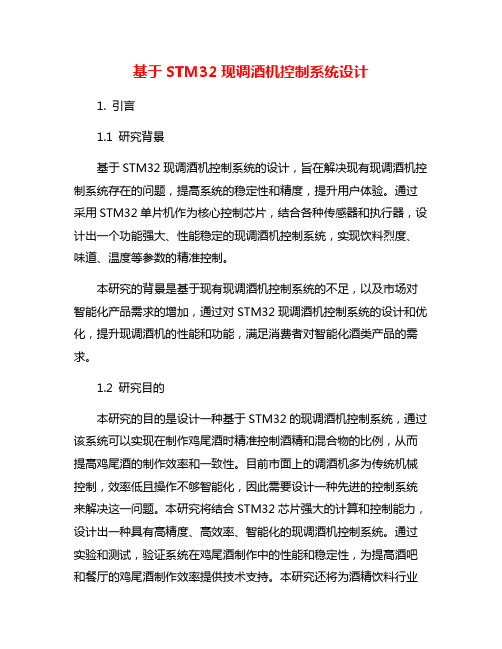
基于STM32现调酒机控制系统设计1. 引言1.1 研究背景基于STM32现调酒机控制系统的设计,旨在解决现有现调酒机控制系统存在的问题,提高系统的稳定性和精度,提升用户体验。
通过采用STM32单片机作为核心控制芯片,结合各种传感器和执行器,设计出一个功能强大、性能稳定的现调酒机控制系统,实现饮料烈度、味道、温度等参数的精准控制。
本研究的背景是基于现有现调酒机控制系统的不足,以及市场对智能化产品需求的增加,通过对STM32现调酒机控制系统的设计和优化,提升现调酒机的性能和功能,满足消费者对智能化酒类产品的需求。
1.2 研究目的本研究的目的是设计一种基于STM32的现调酒机控制系统,通过该系统可以实现在制作鸡尾酒时精准控制酒精和混合物的比例,从而提高鸡尾酒的制作效率和一致性。
目前市面上的调酒机多为传统机械控制,效率低且操作不够智能化,因此需要设计一种先进的控制系统来解决这一问题。
本研究将结合STM32芯片强大的计算和控制能力,设计出一种具有高精度、高效率、智能化的现调酒机控制系统。
通过实验和测试,验证系统在鸡尾酒制作中的性能和稳定性,为提高酒吧和餐厅的鸡尾酒制作效率提供技术支持。
本研究还将为酒精饮料行业的自动化制作技术发展做出一定贡献,推动酒精饮料制作工艺的现代化和智能化发展。
通过本研究,将为控制系统在鸡尾酒制作领域的应用开辟新的方向,为未来鸡尾酒制作技术的改进和创新提供参考和借鉴。
1.3 研究意义通过本次研究,我们可以充分了解现调酒机控制系统的工作原理和设计方法,为相关领域的研究和应用提供参考。
我们还可以通过优化系统性能来提升现调酒机的工作效率和稳定性,为餐饮行业的发展做出贡献。
本次研究对于推动现调酒机控制系统的发展和应用具有重要意义,可以为人们提供更加高效、便捷的酒水调制服务,提升整个餐饮行业的发展水平。
2. 正文2.1 硬件设计硬件设计部分是现调酒机控制系统设计中至关重要的一环。
在硬件设计中,我们首先需要考虑采用什么类型的主控芯片。
基于STM32集成于方向盘的酒精检测系统

设计制作数码世界 P .131基于STM32集成于方向盘的酒精检测系统张茜 朱庆宇 郑铸 河北农业大学信息科学与技术学院摘要:针对酒驾这一现象,本团队设计出一套酒精检测系统,本系统的功能是通过镶嵌在方向盘的不同位置的酒精传感器进行数据采集并由STM32进行数据分析,当驾驶员酒精含量超标时,本方向盘可以实现锁定功能并且发送位置信息给驾驶员的家人,达到从根源上解决酒驾事故的目的。
本次设计的亮点在于本系统集成于方向盘内部。
关键词:交通事故 酒精检测 GPS 方向盘前言随着经济的发展、时代的变迁,居民生活水平逐步上升,私家车的数量逐年增多,但交通事故也在逐渐增加,而引起交通事故的主要原因之一便是“酒驾”。
据调查,大约50%—60%的交通事故与酒后驾驶有关,酒后驾驶已经被世界卫生组织列为车祸致死的首要原因。
针对这一现象,本设计应运而生。
1 概述本系统可分为七大模块,分别是核心控制模块,酒精检测模块,GPS 定位模块,定位信息发送模块,电源模块,语音模块(用于语音播放酒精含量是否超标,取代以往的液晶显示屏),锁定模块。
产品的结构图如图1-1所示。
为提高数据采集的精确度,本系统使用多个酒精传感器,分别排布在方向盘的上下左右四个位置,成正交关系,采集的最终数据由STM32芯片进行数据分析。
当驾驶员启动车辆的打火装置后,本系统开始工作,由于酒精传感器需要一定的预热时间,本系统在启动后首先进行一分钟的延迟,之后对驾驶员进行酒精检测,如果驾驶员的酒精含量达标,本系统将播放“您的酒精含量达标,可以驾驶”,否则,本系统播放“您的酒精含量超标,禁止驾驶”,并且启动锁定模块,向车辆的锁定系统发送一个锁定信号请求锁定方向盘,车辆将方向盘锁定后即可达到禁止驾驶员驾驶的目的,于此同时本系统具有定位功能,可以对车辆进行定位并向其关联人员发送经纬度定位信息,被关联人员可通过高德地图等查询经纬度信息所对应的具体位置。
流程图如图1-2所示。
论文——便携式酒精检测仪器设计方案与仿真

个人资料整理仅限学习使用毕业设计(论文>课题名称便携式酒精浓度监测仪的设计与仿真学生姓名罗永如学号0540827048系、年级专业 05级电子信息工程指导教师刘伟职称讲师2009年 5月 10 日摘要本文研究了一款基于单片机的便携式酒精浓度监测仪的设计过程。
该产品可通过声光报警信号来提示驾驶员是否饮酒过度,不适合开车,旨在减少交通事故的发生,具有一定的市场前景和实用价值。
设计中选用AT89C51单片机作为系统主控芯片,采用MQ3气敏传感器进行酒精气体浓度的检测,利用ADC0809进行模数转换后并通过12864液晶显示器进行浓度显示。
同时,设计了键盘控制部分,用于针对不同人士输入不同阈值,当浓度超过阈值时,给出声光报警信号。
软件设计部分采用模块化思想,运用汇编语言进行编程,该检测器的特点在于简洁的硬件结构、高效的软件设计和较高的性价比。
关键字:便携式;酒精浓度;单片机ABSTRACTIn this paper,a microcontroller-basedportable monitor alcohol concentration of the design process. The product can be sound and light alarm signals to prompt the driver whether the excessive drinking,not suitable for driving,aimed at reducing traffic accidents,with a certain degree of market prospects and practical value. AT89C51 single-chip design selected as the system control chip,the use of alcohol MQ3 gas sensors for the detection of gas concentrations using ADC0809 analog-to-digital conversion to and through the concentration of 12864 to show the liquid crystal display. At the same time,part of the design of the keyboard to control for different people for different input threshold,when the concentration exceeds the threshold value,to a silent alarm signal light. Part of modular software design thought,the use of assembly language programming,the characteristics of the detector hardware structure is simple and efficient software design and higher cost performance.Keywords: Portable。
基于STM32的便携式酒精浓度检测仪设计与实现 毕业论文
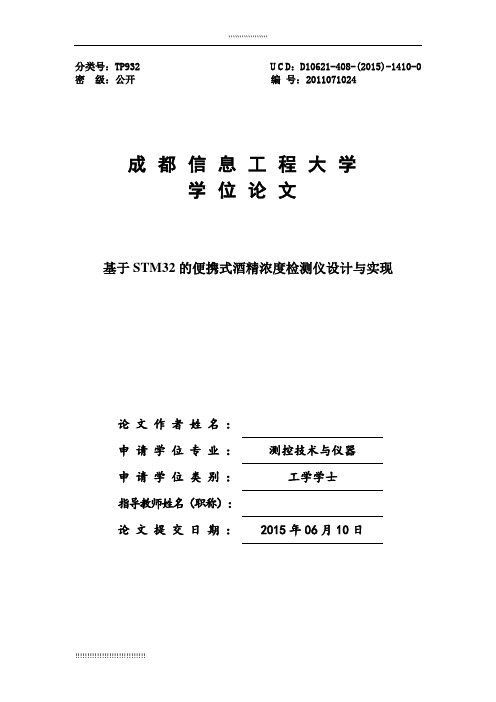
分类号:TP932 U C D:D10621-408-(2015)-1410-0 密级:公开编号:2011071024成都信息工程大学学位论文基于STM32的便携式酒精浓度检测仪设计与实现论文作者姓名:申请学位专业:测控技术与仪器申请学位类别:工学学士指导教师姓名(职称):论文提交日期:2015年06月10日基于STM32的便携式酒精气体浓度检测仪设计与实现摘要近年来,随着我国经济快速发展,给人们也带来了很多利益。
人们的生活和消费水平迅速提高,制造业也在快速地发展。
现在,私家车对于很多人来说已经不再是奢侈品了。
但是交通事故发生概率也大大增加了,尤其是由于酒后驾车而引起的。
如果饮酒过多,会造成体内酒精浓度过高,给饮酒者带来不良的生理反应。
例如,麻痹神经、肢体不受控制、大脑反应迟钝等等。
所以,过量饮酒者开车是一件非常危险的事情,但是少量饮酒并不会有上述症状。
因此,我们需要设计一个能够检测驾驶员体内酒精含量的智能仪器。
目前,许多国家采用呼气酒精检测仪来检测驾驶员体内的酒精含量。
在本课题中使用MQ-3气体传感器采集数据,经过STM32单片机处理,如果浓度值超过标准,系统将给予声光报警,并液晶显示浓度。
关键词:酒驾;MQ-3气体传感器;STM32单片机;酒精含量;声光报警Design of Portable Alcohol Concentration Detection InstrumentBased on STM32AbstractIn recent years, With the rapid development of China's economy , it has brought people a lot of benefits. People's life and consumption level increase rapidly, and manufacturing industry is also developing quickly. Now, the private car for a lot of people have is no longer a luxury. But the traffic accident probability has greatly increased, especially due to drunk driving. If excessive drinking, the alcohol concentration will raise in body, bring the adverse physiological responses to the drinkers. For example, nerve paralysis, body out of control, the slow response of the brain and so on. So, drive after excessive drinking is a very dangerous thing. But a small amount of alcohol does not have these symptoms. At present, in many countries, the breath alcohol detector is used to detect alcohol content in the driver's body. In this paper, the MQ-3 gas sensor is used to collect data, the data is processed through STM32 MCU. If the concentration exceeds the standard, the system will give sound and light alarm, and display concentration through liquid crystal monitor.Key words: drunk driving; MQ-3 alcohol concentration sensor; STM32 MCU; alcohol content; sound and light alarm目录论文总页数:31页1 引言 (1)1.1 课题研究背景及意义 (1)1.2 国内外研究现状 (1)1.3 课题研究思路 (2)2 系统方案设计 (3)2.1 技术指标 (3)2.2 总体设计方案 (3)3 硬件电路设计 (4)3.1 元器件选择 (4)3.1.1 酒精气体传感器 (4)3.1.2 单片机介绍 (6)3.1.3 充电芯片 (10)3.1.4 低压差调节器 (12)3.1.5 显示屏 (12)3.2 主要功能模块电路图 (13)3.2.1 充电及稳压电路模块 (13)3.2.2 传感器及信号调理电路模块 (14)3.2.3 声光报警电路模块 (14)3.2.4 显示屏模块电路 (15)3.3 硬件成品展示 (15)4 软件编程设计 (16)4.1 软件整体设计 (16)4.1.1 整体设计方案 (16)4.1.2 主程序流程图 (16)4.1.3 主程序设计 (17)4.2 数据采集模块程序设计 (18)4.3 液晶显示模块程序设计 (19)4.4 报警模块程序设计 (20)4.5 A/D转换模块程序设计 (21)5 系统调试 (22)5.1 各模块调试 (22)5.1.1 传感器测试 (22)5.1.2 充电电路测试 (22)5.1.3 报警电路测试 (23)5.1.4 系统整体调试 (23)5.2 调试结果分析 (23)5.2.1 测试数据 (23)5.2.2 误差分析 (23)5.3 调试中的问题及解决方案 (24)6 结论 (25)参考文献 (26)致谢 (27)声明............................................................................................................ 错误!未定义书签。
基于STM32单片机的车载酒精检测系统设计
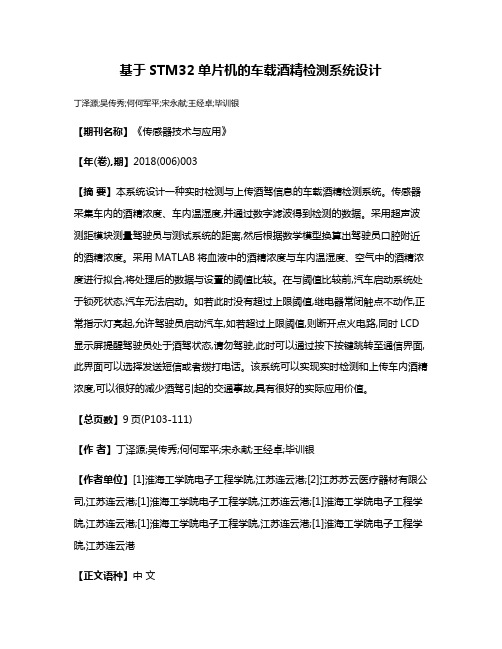
基于STM32单片机的车载酒精检测系统设计丁泽源;吴传秀;何何军平;宋永献;王经卓;毕训银【期刊名称】《传感器技术与应用》【年(卷),期】2018(006)003【摘要】本系统设计一种实时检测与上传酒驾信息的车载酒精检测系统。
传感器采集车内的酒精浓度、车内温湿度,并通过数字滤波得到检测的数据。
采用超声波测距模块测量驾驶员与测试系统的距离,然后根据数学模型换算出驾驶员口腔附近的酒精浓度。
采用MATLAB将血液中的酒精浓度与车内温湿度、空气中的酒精浓度进行拟合,将处理后的数据与设置的阈值比较。
在与阈值比较前,汽车启动系统处于锁死状态,汽车无法启动。
如若此时没有超过上限阈值,继电器常闭触点不动作,正常指示灯亮起,允许驾驶员启动汽车,如若超过上限阈值,则断开点火电路,同时LCD 显示屏提醒驾驶员处于酒驾状态,请勿驾驶,此时可以通过按下按键跳转至通信界面,此界面可以选择发送短信或者拨打电话。
该系统可以实现实时检测和上传车内酒精浓度,可以很好的减少酒驾引起的交通事故,具有很好的实际应用价值。
【总页数】9页(P103-111)【作者】丁泽源;吴传秀;何何军平;宋永献;王经卓;毕训银【作者单位】[1]淮海工学院电子工程学院,江苏连云港;[2]江苏苏云医疗器材有限公司,江苏连云港;[1]淮海工学院电子工程学院,江苏连云港;[1]淮海工学院电子工程学院,江苏连云港;[1]淮海工学院电子工程学院,江苏连云港;[1]淮海工学院电子工程学院,江苏连云港【正文语种】中文【中图分类】TP2【相关文献】1.基于多传感器融合的车载酒精检测系统设计 [J], 徐京莲;韩峻峰;潘盛辉;童启武2.基于CC1110的车载主动酒精检测系统设计 [J], 孙丹;赵奎兵;段富海3.基于PLC的车载酒精检测智能机械手系统设计 [J], 蔡维;史玉峰;廖宇兰;李朋伟;陈阳;王亚坤;王涛4.基于驾驶员身份认证的车载酒精检测系统设计 [J], 展召敏;严一滨;;5.基于单片机的车载酒精检测系统 [J], 毛夏煜;王雨凡;牛迁迁;刘瑶;冯兴乐因版权原因,仅展示原文概要,查看原文内容请购买。
基于STM32现调酒机控制系统设计
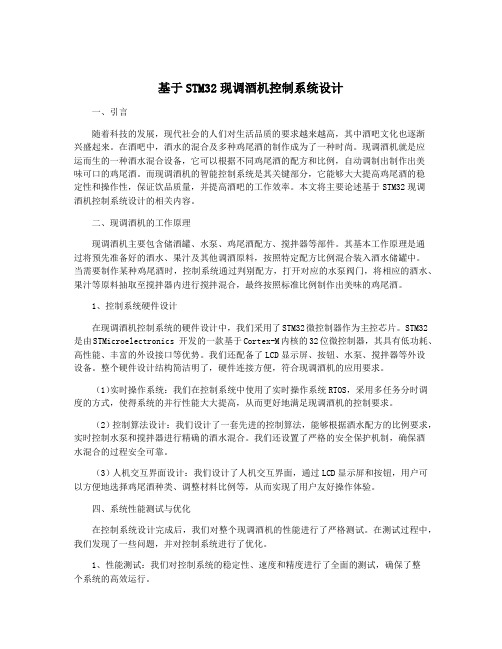
基于STM32现调酒机控制系统设计一、引言随着科技的发展,现代社会的人们对生活品质的要求越来越高,其中酒吧文化也逐渐兴盛起来。
在酒吧中,酒水的混合及多种鸡尾酒的制作成为了一种时尚。
现调酒机就是应运而生的一种酒水混合设备,它可以根据不同鸡尾酒的配方和比例,自动调制出制作出美味可口的鸡尾酒。
而现调酒机的智能控制系统是其关键部分,它能够大大提高鸡尾酒的稳定性和操作性,保证饮品质量,并提高酒吧的工作效率。
本文将主要论述基于STM32现调酒机控制系统设计的相关内容。
二、现调酒机的工作原理现调酒机主要包含储酒罐、水泵、鸡尾酒配方、搅拌器等部件。
其基本工作原理是通过将预先准备好的酒水、果汁及其他调酒原料,按照特定配方比例混合装入酒水储罐中。
当需要制作某种鸡尾酒时,控制系统通过判别配方,打开对应的水泵阀门,将相应的酒水、果汁等原料抽取至搅拌器内进行搅拌混合,最终按照标准比例制作出美味的鸡尾酒。
1、控制系统硬件设计在现调酒机控制系统的硬件设计中,我们采用了STM32微控制器作为主控芯片。
STM32是由STMicroelectronics 开发的一款基于Cortex-M内核的32位微控制器,其具有低功耗、高性能、丰富的外设接口等优势。
我们还配备了LCD显示屏、按钮、水泵、搅拌器等外设设备。
整个硬件设计结构简洁明了,硬件连接方便,符合现调酒机的应用要求。
(1)实时操作系统:我们在控制系统中使用了实时操作系统RTOS,采用多任务分时调度的方式,使得系统的并行性能大大提高,从而更好地满足现调酒机的控制要求。
(2)控制算法设计:我们设计了一套先进的控制算法,能够根据酒水配方的比例要求,实时控制水泵和搅拌器进行精确的酒水混合。
我们还设置了严格的安全保护机制,确保酒水混合的过程安全可靠。
(3)人机交互界面设计:我们设计了人机交互界面,通过LCD显示屏和按钮,用户可以方便地选择鸡尾酒种类、调整材料比例等,从而实现了用户友好操作体验。
基于STM32现调酒机控制系统设计

基于STM32现调酒机控制系统设计
现调酒机是一种自动化的酒水调配设备,能够根据用户的需求自动调配出各种酒水。
本文将基于STM32单片机设计一个现调酒机控制系统。
系统的主要功能包括:酒水配方管理、酒水调配、用户界面交互。
酒水配方管理模块:这个模块用于管理酒水的配方信息,包括酒精度、配料比例、酒
水名称等。
可以通过PC机或者其他设备将配方信息上传到STM32单片机中。
酒水调配模块:这个模块是系统的核心部分,负责根据用户的需求和酒水配方信息进
行自动调配。
当用户选择了酒水种类和需求酒精度后,系统会根据配方信息计算出所需的
配料比例,并通过电磁阀将相应的配料加入到容器中。
用户界面交互模块:这个模块用于与用户进行交互,包括选择酒水种类、设置酒精度、启动调配等功能。
可以通过LCD显示屏和触摸按键进行交互。
硬件方面,可以使用STM32F407单片机作为控制核心,它具有较强的计算和IO控制能力。
需要配备电磁阀、传感器等外围设备,用于控制酒水调配和监测酒精度等。
软件方面,可以用C语言编写控制程序,实现酒水配方管理、酒水调配和用户界面交
互等功能。
可以利用STM32的开发环境进行开发,同时可以借助相关的库函数和驱动程序
简化开发过程。
基于STM32现调酒机控制系统设计

基于STM32现调酒机控制系统设计【摘要】本文基于STM32现调酒机控制系统设计,分别介绍了STM32单片机的特点和应用,以及酒水调配系统的设计原理。
从电路设计、软件设计到系统集成,详细描述了控制系统的各个模块及其功能。
实验结果分析表明,该系统具有良好的稳定性和准确性,能够满足酒水调配的需求。
文章还对系统中存在的问题进行了分析,并展望了未来的发展方向。
通过本文的研究,可以为饮品行业提供一种智能化的调酒解决方案,提升饮品调配的效率和品质。
【关键词】STM32单片机,酒水调配系统,电路设计,软件设计,系统集成,实验结果分析,问题与展望,研究背景,研究目的,研究意义.1. 引言1.1 研究背景酒水调配机器在酒吧和餐厅等场所得到了广泛应用,可以提高调酒效率、减少人力成本,并且能够保证酒水的准确配比。
目前市面上的酒水调配机器大多采用传统的控制方式,存在着配比精度不高、操作复杂、维护困难等问题。
设计一种基于STM32的现调酒机控制系统,具有非常重要的实际意义。
STM32单片机是STMicroelectronics公司推出的一款高性能、低功耗的嵌入式微控制器,具有丰富的外设资源和强大的处理能力,在工业控制领域有着广泛的应用。
借助STM32单片机的高性能和可靠性,我们可以设计出一个稳定可靠、精确调控的酒水调配系统。
本研究旨在基于STM32单片机设计一种酒水调配系统,实现对酒精度和调配精度的精准控制。
通过研究和设计,我们希望解决现有调酒机器的配比精度不高、操作繁琐等问题,提高调酒效率,降低人工成本,同时为酒吧和餐厅等场所带来更好的用户体验。
1.2 研究目的本文的研究目的主要是基于STM32现调酒机控制系统设计,旨在实现一种高效、精准的酒水调配系统。
通过对STM32单片机的介绍和酒水调配系统设计,我们将探讨如何有效地控制调配酒水的比例和浓度,以满足用户对不同种类酒水的需求。
本研究还将详细讨论电路设计和软件设计的方案,以确保系统稳定性和可靠性。
基于STM32现调酒机控制系统设计

基于STM32现调酒机控制系统设计随着科技的发展和人们生活水平的提高,现调酒机已成为各大餐饮场所不可或缺的设备之一。
现调酒机的出现不仅提高了调酒效率,还能够保证酒水的质量和口感。
为了更好地控制现调酒机的工作流程,提高其自动化程度和智能化水平,我们设计了一套基于STM32的现调酒机控制系统。
一、现调酒机的工作原理现调酒机是一种利用电子设备按照预设程序自动混合酒水的装置。
其工作原理大致分为以下几个步骤:1. 接收指令:接收用户的操作指令,包括选择酒水种类、容量、浓度等。
2. 混合酒水:按照预设程序自动混合酒水,确保质量和口感。
3. 出酒:将混合好的酒水通过出酒口输出,完成整个酒水调配过程。
二、现调酒机控制系统的设计要求基于STM32的现调酒机控制系统需要满足以下几个设计要求:1. 稳定性:控制系统需要保证现调酒机的稳定运行,确保酒水的质量和口感稳定。
2. 灵活性:控制系统需要具有一定的灵活性,能够适应不同种类酒水的混合和调配。
3. 智能化:控制系统需要具有一定的智能化水平,能够根据用户需求自动调整混合比例和浓度。
4. 易操作性:控制系统需要具有良好的用户界面和操作逻辑,方便用户进行操作和管理。
三、基于STM32的现调酒机控制系统设计方案基于STM32的现调酒机控制系统主要由控制模块、通信模块、传感器模块和执行模块四个部分组成。
1. 控制模块:控制模块是整个系统的核心部分,负责实现酒水混合流程的控制和调配。
控制模块通过STM32芯片控制混合阀、泵和其他执行元件的工作,实现酒水的自动混合和调配过程。
2. 通信模块:通信模块负责与用户界面进行通信,接收用户操作指令并将指令传输给控制模块。
通信模块可以采用串口通信或者Wi-Fi通信,实现与用户界面的数据交换和信息传递。
3. 传感器模块:传感器模块用于检测酒水的流量、浓度、温度等参数,向控制模块提供实时的反馈信息。
传感器模块可以采用流量传感器、浓度传感器、温度传感器等,确保酒水的质量和口感。
基于STM32现调酒机控制系统设计

基于STM32现调酒机控制系统设计一、设计思路现调酒机是一种基于Microcontroller的贮存、控制、加料与搅拌的独立工作系统。
在实现控制系统功能的基础上,需要考虑系统的控制算法、系统的稳定性、系统的可靠性、系统的安全性等方面。
基于这些要求,我们采用STM32作为控制核心,对现调酒机控制系统进行设计。
二、硬件设计1. Microcontroller选择由于现调酒机所需要控制的贮存、控制、加料与搅拌等都需要一个高效、功能强大的控制器来完成,为此我们选择了STM32系列作为控制器。
STM32控制器具有较强的性能、低功耗、高精度、高可靠性等特点,并且与主流的开发工具和开发平台兼容,因此可以方便地进行开发和调试。
2. 电源设计现调酒机需要外部供电,根据其负载计算得出功率需求值为60W。
采用金属膜电阻分压式稳压电路提供合适的电源电压,确保电路稳定工作。
3. 传感器现调酒机需要添加重量传感器和温度传感器来进行监测。
重量传感器采用电子称的原理,通过计算得出酒精和饮料的重量比例进行调配;温度传感器则读取冰块桶内的温度,以便及时触发冰水搅拌器。
4. 外设包括LED数码管、按键、LCD显示屏、蜂鸣器等外围设备的驱动控制,通过STM32的GPIO、UART、SPI、I²C等模块进行控制。
1. 主控程序设计主程序实现了现调酒机准确计算酒精和饮料的重量比例,并向用户输出配酒的详细信息。
其中,还需实现外部按键的检测、LED数码管和LCD显示屏的显示、蜂鸣器的控制、重量传感器、温度传感器的温度读取等操作。
2. 重量传感器计算及实现程序设计根据重量传感器读取的数据,通过数学函数实现酒精和饮料比例的计算,并将其显示到LED数码管和LCD屏幕上。
其中,还需实现称重过程中的状态处理,如称重过程中的误差处理、称重结束后的数值调整、饮料及酒精重量的清零等操作。
温度传感器通过读取桶内的温度,当桶内的温度低于设定的值时,通过蜂鸣器发出告警,提示用户要加入银丝杯并搅拌,以便将酒水冷却。
- 1、下载文档前请自行甄别文档内容的完整性,平台不提供额外的编辑、内容补充、找答案等附加服务。
- 2、"仅部分预览"的文档,不可在线预览部分如存在完整性等问题,可反馈申请退款(可完整预览的文档不适用该条件!)。
- 3、如文档侵犯您的权益,请联系客服反馈,我们会尽快为您处理(人工客服工作时间:9:00-18:30)。
基于STM32的便携式酒精浓度检测仪设计与实现论文作者姓名:申请学位专业:测控技术与仪器申请学位类别:工学学士指导教师姓名(职称):论文提交日期:基于STM32的便携式酒精气体浓度检测仪设计与实现摘要近年来,随着我国经济快速发展,给人们也带来了很多利益。
人们的生活和消费水平迅速提高,制造业也在快速地发展。
现在,私家车对于很多人来说已经不再是奢侈品了。
但是交通事故发生概率也大大增加了,尤其是由于酒后驾车而引起的。
如果饮酒过多,会造成体内酒精浓度过高,给饮酒者带来不良的生理反应。
例如,麻痹神经、肢体不受控制、大脑反应迟钝等等。
所以,过量饮酒者开车是一件非常危险的事情,但是少量饮酒并不会有上述症状。
因此,我们需要设计一个能够检测驾驶员体内酒精含量的智能仪器。
目前,许多国家采用呼气酒精检测仪来检测驾驶员体内的酒精含量。
在本课题中使用MQ-3气体传感器采集数据,经过STM32单片机处理,如果浓度值超过标准,系统将给予声光报警,并液晶显示浓度。
关键词:酒驾;MQ-3气体传感器;STM32单片机;酒精含量;声光报警Design of Portable Alcohol Concentration Detection InstrumentBased on STM32AbstractIn recent years, With the rapid development of China's economy , it has brought people a lot of benefits. People's life and consumption level increase rapidly, and manufacturing industry is also developing quickly. Now, the private car for a lot of people have is no longer a luxury. But the traffic accident probability has greatly increased, especially due to drunk driving. If excessive drinking, the alcohol concentration will raise in body, bring the adverse physiological responses to the drinkers. For example, nerve paralysis, body out of control, the slow response of the brain and so on. So, drive after excessive drinking is a very dangerous thing. But a small amount of alcohol does not have these symptoms. At present, in many countries, the breath alcohol detector is used to detect alcohol content in the driver's body. In this paper, the MQ-3 gas sensor is used to collect data, the data is processed through STM32 MCU. If the concentration exceeds the standard, the system will give sound and light alarm, and display concentration through liquid crystal monitor.Key words: drunk driving; MQ-3 alcohol concentration sensor; STM32 MCU; alcohol content; sound and light alarm目录论文总页数:31页1 引言 (1)1.1 课题研究背景及意义 (1)1.2 国内外研究现状 (1)1.3 课题研究思路 (2)2 系统方案设计 (3)2.1 技术指标 (3)2.2 总体设计方案 (3)3 硬件电路设计 (4)3.1 元器件选择 (4)3.1.1 酒精气体传感器 (4)3.1.2 单片机介绍 (6)3.1.3 充电芯片 (10)3.1.4 低压差调节器 (12)3.1.5 显示屏 (12)3.2 主要功能模块电路图 (13)3.2.1 充电及稳压电路模块 (13)3.2.2 传感器及信号调理电路模块 (14)3.2.3 声光报警电路模块 (14)3.2.4 显示屏模块电路 (15)3.3 硬件成品展示 (15)4 软件编程设计 (16)4.1 软件整体设计 (16)4.1.1 整体设计方案 (16)4.1.2 主程序流程图 (16)4.1.3 主程序设计 (17)4.2 数据采集模块程序设计 (18)4.3 液晶显示模块程序设计 (19)4.4 报警模块程序设计 (20)4.5 A/D转换模块程序设计 (21)5 系统调试 (22)5.1 各模块调试 (22)5.1.1 传感器测试 (22)5.1.2 充电电路测试 (22)5.1.3 报警电路测试 (23)5.1.4 系统整体调试 (23)5.2 调试结果分析 (23)5.2.1 测试数据 (23)5.2.2 误差分析 (23)5.3 调试中的问题及解决方案 (24)6 结论 (25)参考文献 (26)致谢 (27)声明 (28)附件 (29)1 引言1.1 课题研究背景及意义据统计,2011年我国共生产了白酒约1026万吨,排除重复统计的数据,实际的消费量为800万吨。
如果把消费群体定位在15岁以上的成人,当时我国约有11.5亿15岁以上的成人,那么可以计算出当时我国成人人均消费的白酒为6.96升。
另外,还有啤酒,洋酒,红酒的消费,当时我国人均消费的啤酒约为36升、洋酒约为1.2升、红酒约为1.24升。
如果按照白酒的酒精含量65%、红酒的酒精含量10%、洋酒的酒精含量40%、啤酒的酒精含量4%来计算,那么当时我国人均纯酒精消费量约为6.566升。
但是随着我国的经济快速发展,人们的生活、消费水平也逐渐提高,酒精的消费量也再快速的增长,由于饮酒过多而造成的社会安全问题也频频发生。
比如由于酒驾引起的交通事故等等。
当酒精在人体血液里达到一定浓度的时候,会导致驾驶者神经麻痹、触觉能力降低、判断能力和操作能力也会降低。
并且会使驾驶员视力暂时受损,分辨颜色的能力下降,视像不稳等,这些症状会使驾驶者不能发现或正确领会标志、标线、交通信号灯所要表达的意思,在这种情况下,驾驶员几乎失去了驾驶能力,发生交通事故的概率极限增加。
据世界卫生组织调查,由于酒后驾车造成的交通事故的数量非常庞大,大约占所有交通事故的50%—69%,而且由酒驾造成的交通事故后果一般都非常严重,所以酒后驾车已经被认为是车祸致死的主要原因。
在中国,每年都有数万起交通事故是由于酒后驾车而造成的,因此交通事故的第一“杀手”被认为是酒后驾车。
1.2 国内外研究现状目前,电化学性质的酒精检测仪在全世界是使用得最多的。
酒精检测仪根据显示方式的不同主要分为两种:其中一种是发光管显示。
最常见的发光管显示是三段式显示,其中未饮酒区为第一段,饮酒区为第二段,酗酒区为第三段。
并且每一段都有一个不同颜色的LED灯,根据测试的结果,来点亮对应那一段的LED 指示灯。
另一种酒精测试仪是数码管显式,它是以数字的形式来显示检测的结果。
而这两年出现了一种新型的半导体酒精检测仪,它就是一种拥有高可靠性、高精度、呼吸式等特点的酒精浓度检测仪ca2000。
新型高科技微变氧化物半导体是它的核心部件,可以非常准确的检测气体的酒精含量,而且不会受非酒精类气体的干扰,比如烟味、可乐、咖啡等等。
ca2000拥有小巧轻便,操作简单等特点,所以它是便携应用的最佳选择[1,2]。
如果驾驶员喝了酒,那么他呼出的气体中就含有酒精气体,所以为了检查酒驾,便携式的酒精检测仪得到了交警的广泛使用。
而目前使用的酒精检测仪检测驾驶员是否饮酒只能够初步的判断,最终还需要通过血检来检测驾驶员体内的酒精含量,来判定驾驶员是不是构成了酒驾。
为了检测更方便,一种超级酒精呼吸检测仪诞生了,它是由英国内政部推出的。
这种酒精检测仪不仅仅是通过驾驶员体内的酒精含量来判断驾驶员是否酒驾,它还根据驾驶员的体温,呼吸频率等多方面的因素当场判断驾驶者是否酒驾[3]。
受20世纪信息技术快速发展的影响,传感器技术已经发展到了一个非常高的地步了,在各个领域都得到了广泛的使用,扮演着非常重要的角色。
因此酒精浓度检测仪应该向着高精度,高可靠性,高稳定性与微型化的方向发展。
到目前为止,检测酒精气体含量的设备主要分为5种类型,它们分别是:燃料电池型(电化学)、气体色谱分析型、比色型、半导体型和红外线型。
其中燃料电池和半导体型这两种类型的酒精含量检测仪在价格这方面比起其他类型的较便宜,而且使用起来非常方便。
所以这两种类型的酒精含量检测仪使用得比较多。
环保型能源燃料电池可以直接把可燃气体转变为电能,而在整个过程中却不产生污染,所以全世界都在广泛的研究。
而酒精传感器只是研究燃料电池的一个小小的分支。
因此燃料电池型酒精传感器诞生,它的原理是:使用贵金属铂金作为电极,在燃烧室内燃烧酒精,在燃烧的过程中使用了特种催化剂,使酒精充分燃烧。
并且转变成电能,也就是在两个电极上产生了电压,由此转换来的电压与在燃烧室内燃烧的气体的酒精浓度是成正比的,在外部通过接入负载来消耗电能[4,5]。
燃料电池型酒精浓度检测仪与半导体型的相比,它具有以下几个优点1) 稳定性好2) 精度高3) 抗干扰能力强的优点但是燃料电池型酒精传感器也存在一些致命缺点,比如说在制造过程中对传感器的结构要求非常精密,制造难度非常大等。
所以目前能够生产燃料电池型酒精传感器的只有少数几个国家,比如美国、英国和德国等,再加上制造成本高,所以成品的价格较贵,与半导体型酒精传感器比起来贵几十倍。
所以在日常生活中用得最多的还是半导体型酒精传感器[6]。
1.3 课题研究思路伴随着单片机(MCU)技术的快速发展和日益完善,单片机在我们的日常生活中已经是屡见不鲜了,我们将它应用于各个领域。
从智能控制到监测方面,与其他技术相比,单片机的优越性是非常的明显。
本课题研究的是一种以酒精浓度传感器和STM32单片机为主,对空气中的酒精浓度值进行检测,并且将浓度值通过LED显示屏显示出来,最终对超过阀值的浓度值进行声光报警。
